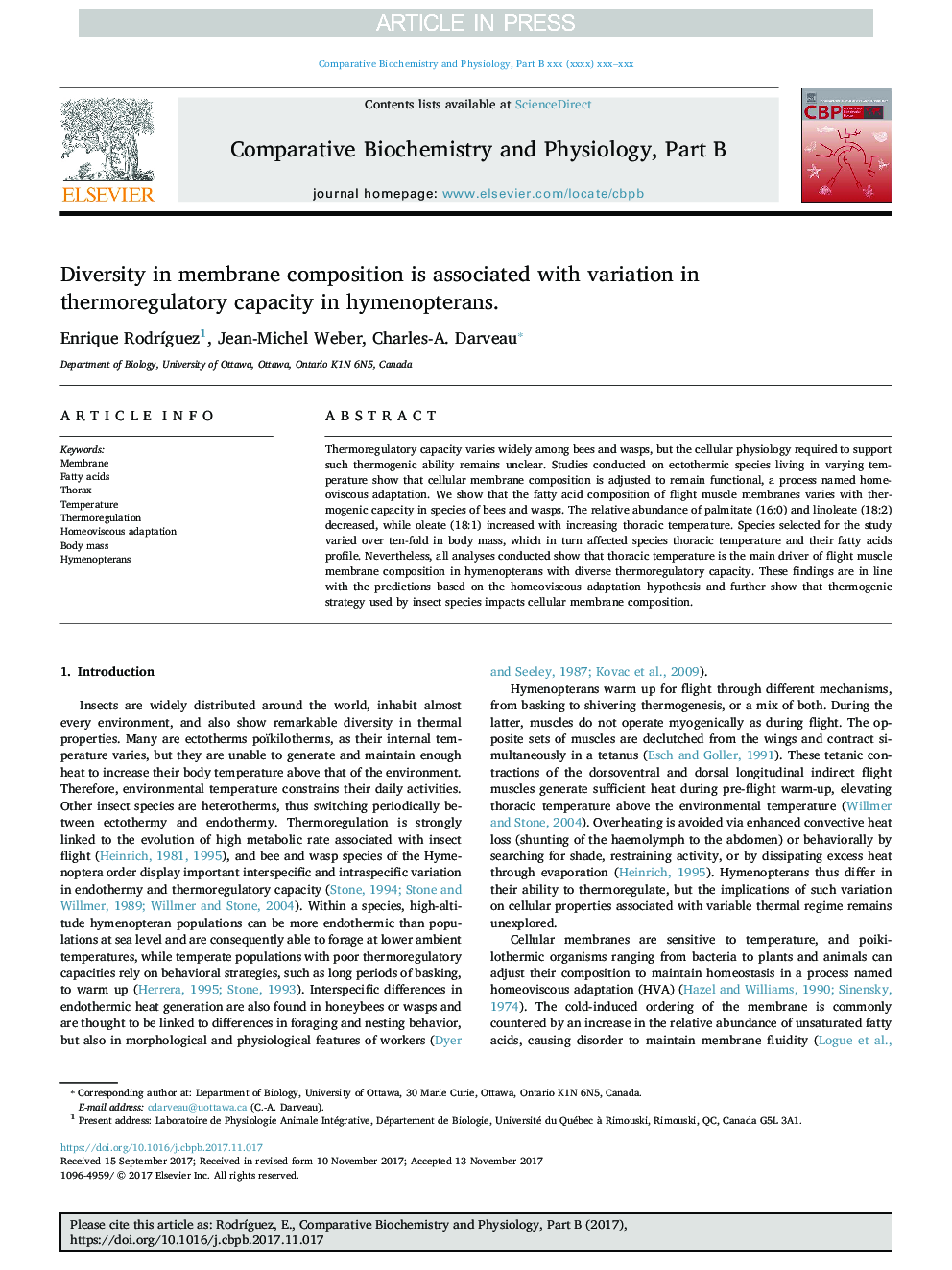| کد مقاله | کد نشریه | سال انتشار | مقاله انگلیسی | نسخه تمام متن |
|---|---|---|---|---|
| 8318783 | 1539113 | 2018 | 6 صفحه PDF | دانلود رایگان |
عنوان انگلیسی مقاله ISI
Diversity in membrane composition is associated with variation in thermoregulatory capacity in hymenopterans.
ترجمه فارسی عنوان
تنوع در ترکیب غشا با تغییرات ظرفیت حرارتی در هیمنوپترها مرتبط است.
دانلود مقاله + سفارش ترجمه
دانلود مقاله ISI انگلیسی
رایگان برای ایرانیان
کلمات کلیدی
ترجمه چکیده
ظرفیت ترموکوپل در بین زنبورها و زنبورها به طور گسترده ای متفاوت است، اما فیزیولوژی سلولی مورد نیاز برای حمایت از چنین توان حرارتی هنوز مشخص نیست. مطالعات انجام شده بر روی گونه های اکتوترمی که در دمای متغیر زندگی می کنند نشان می دهد که ترکیب غشاء سلولی برای عملکرد باقی مانده، فرآیند سازگاری با صفحه خانگی است. ما نشان می دهد که ترکیب اسید چرب غشاء عضلانی پرواز با ظرفیت ترموژنیک در گونه های زنبورها و زنبورها متفاوت است. فراوانی نسبی پالمیتات (16: 0) و لینولئات (18: 2) کاهش می یابد، در حالی که اولئات (18: 1) با افزایش دمای سینه افزایش می یابد. گونه های انتخاب شده برای مطالعه بیش از ده برابر در جرم بدن متفاوت است که به نوبه خود بر درجه حرارت توراسیک گونه و مشخصات اسید چرب آنها تاثیر می گذارد. با این وجود، تمام تحلیلی که انجام شده نشان می دهد که دمای توراکس راننده اصلی ترکیب غشاء عضله پرواز در هیمنوپترها با ظرفیت گرماسنجی متنوع است. این یافته ها مطابق پیش بینی های مبتنی بر فرضیه سازگاری خانه ای است و نشان می دهد که استراتژی ترموژنیک استفاده شده توسط گونه های حشرات بر ترکیب غشاء سلولی تأثیر می گذارد.
موضوعات مرتبط
علوم زیستی و بیوفناوری
بیوشیمی، ژنتیک و زیست شناسی مولکولی
زیست شیمی
چکیده انگلیسی
Thermoregulatory capacity varies widely among bees and wasps, but the cellular physiology required to support such thermogenic ability remains unclear. Studies conducted on ectothermic species living in varying temperature show that cellular membrane composition is adjusted to remain functional, a process named homeoviscous adaptation. We show that the fatty acid composition of flight muscle membranes varies with thermogenic capacity in species of bees and wasps. The relative abundance of palmitate (16:0) and linoleate (18:2) decreased, while oleate (18:1) increased with increasing thoracic temperature. Species selected for the study varied over ten-fold in body mass, which in turn affected species thoracic temperature and their fatty acids profile. Nevertheless, all analyses conducted show that thoracic temperature is the main driver of flight muscle membrane composition in hymenopterans with diverse thermoregulatory capacity. These findings are in line with the predictions based on the homeoviscous adaptation hypothesis and further show that thermogenic strategy used by insect species impacts cellular membrane composition.
ناشر
Database: Elsevier - ScienceDirect (ساینس دایرکت)
Journal: Comparative Biochemistry and Physiology Part B: Biochemistry and Molecular Biology - Volume 224, October 2018, Pages 115-120
Journal: Comparative Biochemistry and Physiology Part B: Biochemistry and Molecular Biology - Volume 224, October 2018, Pages 115-120
نویسندگان
Enrique RodrÃguez, Jean-Michel Weber, Charles-A. Darveau,
